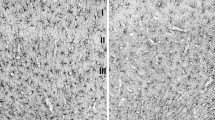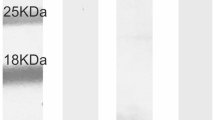Abstract
The distribution of glial fibrillary acidic protein (GFAP)-immunoreactivity is described in serial Vibratome sections of the turtle brain. The results are discussed in relation to our previous studies of rat and chicken brains. In the turtle brain, the distribution of GFAP-positive elements is rather evenly abundant as compared to that observed in the chicken and rat. The GFAP-positive structures are fibers of different length and orientation, but the stellate cells are not GFAP-positive. The basic systems is the radial ependymoglia, directed from the ventricles toward the outer surface of the brain. This system also contains some transverse and randomly oriented fibers. The cell bodies are not usually GFAP-positive. The large brain tracts could be recognized by their weak immunostaining, but gray matter nuclei could not be identified on the basis of immunostaining against GFAP. The layers of the optic tectum could be distinguished, as well as the gray and white matter of brain stem and spinal cord and the molecular and granular layers of the cerebellum. In the cerebellum, a fiber system resembling the Bergmann-fibers, a strong midline raphe and coarse transverse fibers could be observed. These latter fibers have no equivalent in other cerebella. Their perikarya proved also to be GFAP-positive, and seemed to be dividing in the adult turtle brain. We conclude that the appearance of GFAP-positive stellate cells had a great importance in the evolution of avian and mammalian brains strengthening the thicker brain walls and assisting in the formation of local differences of GFAP-immunoreactivity in different brain areas.
Similar content being viewed by others
References
Alvarez-Buylla A, Theelen M, Nottebohm F (1990) Proliferation “hot spots” in adult avian ventricular zone reveal radial cell division. Neuron 5:101–109
Ariëns Kappers CU, Huber CG, Crosby EC (1960) The comparative anatomy of the nervous system of vertebrates, including man. Hafner, New York
Bignami A, Dahl D (1974) The development of Bergmann glia in mutant mice with cerebellar malformations: reeler, staggerer and weaver. Immunofluorescence study with antibodies to the glial fibrillary acidic protein. J Comp Neurol 155:219–230
Connor JR, Berkowitz RM (1985) A demonstration of glial filament distribution in astrocytes isolated from rat cerebral cortex. Neuroscience 16:33–44
Connors BW, Kriegstein AR (1986) Cellular physiology of the turtle visual cortex: distinctive properties of pyramidal and stellate neurons. J Neurosci 6:167–177
Dahl D, Bignami A (1973) Immunohistochemical and immunofluorescence studies of the glial fibrillary acidic protein in vertebrates. Brain Res 61:279–293
Dahl D, Crosby CJ, Sethi A, Bignami A (1985) Glial fibrillary acidic (GFA) protein in vertebrates: immunofluorescence and immunoblotting study with monoclonal and polyclonal antibodies. J Comp Neurol 239:75–88
Davydova TV, Goncharova NV (1979) Comparative characterization of the basic forebrain cortical zones in Emys orbicularis (Linneaus) and Testudo horsfieldi (Gray). J Hirnforsch 20:245–265
Debus E, Weber K, Osborn M (1983) Monoclonal antibodies specific for glial fibrillary acidic (GFA) protein and for each of the neurofilament triplet polypeptides. Differentation 25:193–203
Eberhardt W, Reichenbach A (1987) Spatial buffering of potassium by retinal Müller (glial) cells of various morphologies calculated by a model. Neuroscience 36:121–144
Hajós F, Bascó E (1984) The surface contact glia. Adv Anat Embryol Cell Biol 84:1–81
Hajós F, Kálmán M (1989) Distribution of glial fibrillary acidic protein (GFAP)-immunoreactive astrocytes in the rat brain. II. Mesencephalon, rhombencephalon and spinal cord. Exp Brain Res 78:164–173
Joosten EAJ, Gribnau AAM (1989) Astrocytes and guidance of outgrowing corticospinal tract axons in the rat. An immunocytochemical study using anti-vimentin and anti-glial fibrillary acidic protein. Neuroscience 31:439–452
Kálmán M (1993) Vimentin persists in the mature glia of fish brain. Neurobiology 1:47–54
Kálmán M, Hajós F (1989) Distribution of glial fibrillary acidic protein (GFAP)-immunoreactive astrocytes in the rat brain. I. Forebrain. Exp Brain Res 78:147–163
Kálmán M, Korpás DI, Török C (1989) GFAP-immunopositivity in developing rat brain. Eur J Neurosci [Suppl 2]:47
Kálmán M, Székely A, Csillag A (1993a) Distribution of glial fibrillary acidic protein-immunopositive structures in the brain of the domestic chicken (Gallus domesticus). J Comp Neurol 330:221–237
Kálmán M, Székely A, Csillag A (1993b) GFAP and vimentin in the developing chicken brain. Anat Anz [Suppl 175]: 130–131
Korte GE, Rosenbluth J (1981) Ependymal astrocytes in frog cerebellum. Anat Rec 199:267–279
Kótai I, Hajós F, Seress L (1989) Comparative study of glial fibrillary acidic protein (GFAP)-immunoreactivity in the rat and monkey cerebellum. Acta Morphol Hung 37:85–92
Kriegstein AR, Shen JM, Eshhar N (1986) Monoclonal antibodies to the turtle cortex reveal neuronal subsets, antigenic cross-reactivity with the mammalian neocortex, and forebrain structures sharing a pallial derivation. J Comp Neurol 254:330–340
Kuenzel WJ, Masson M (1988) A stereotaxic atlas of the brain of the chick (Gallus domesticus). The Johns Hopkins University Press, Baltimore
Linser PJ (1985) Multiple marker analysis in the avian optic tectum reveals three classes of neuroglia and carbonic anhydrase-containing neurons. J Neurosci 5:2388–2396
Ludwin SK, Kosek JC, Eng LF (1976) The topographical distribution of S-100 and GFA proteins in the adult rat brain: an immunocytochemical study using horseradish peroxidase-labelled antibodies. J Comp Neurol 165:197–208
Monzon-Mayor M, Yanes C, Tholey G, Barry J de, Gombos G (1990) Glial fibrillary acidic protein and vimentin immunohistochemistry in the developing and adult midbrain of the lizard Gallotia galloti. J Comp Neurol 295:569–579
Onteniente B, Kimura H, Maeda T (1983) Comparative study of the glial fibrillary acidic protein in vertebrates by PAP immunohistochemistry. J Comp Neurol 215:427–436
Patel AJ, Weir MO, Hunt A, Tahourdin CSM, Thomas DGT (1985) Distribution of glutamine synthetase and glial fibrillary acidic protein and correlation with glutamate decarboxylase in different regions of the rat central nervous system. Brain Res 331:1–9
Powers AS, Reiner A (1980) A stereotaxic atlas of the forebrain and midbrain of the eastern painted turtle (Chrysemys picta picta). J Hirnforsch 21:125–159
Rakic P (1981) Neuronal-glial interaction during development. Trends Neurosci 4:184–187
Reiner A (1991) A comparison of neurotransmitter-specific and neuropeptide-specific neuronal cell types present in the dorsal cortex in turtles with those present in the isocortex of mammals: implications for the evolution of isocortex. Brain Behav Evol 38:53–91
Riss W, Halpern M, Scalia F (1969) The quest for clues to forebrain evolution — the study of reptiles. Brain Behav Evol 2:1–50
Roeling TAP, Feirabend HKP (1988) Glial fiber pattern in the developing chicken cerebellum: vimentin and glial fibrillary acidic protein (GFAP) immunostaining. Glia 1:398–402
Romer AS (1959) Ther vertebrate story. University of Chicago Press, Chicago
Romer AS (1972) The vertebrate body. Saunders, Philadelphia
Schachner M, Hedley-White ET, Hsu DW, Schoonmaker G, Bignami A (1977) Ultrastructural localization of glial fibrillary acidic protein in mouse cerebellum by immunoperoxidase labelling. J Cell Biol 75:67–73
Silver J, Lorenz SE, Wahlstein D, Coughlin J (1982) Axonal guidance during development of the great cerebral commissures: descriptive and experimental studies in vivo on the role of preformed glial pathways. J Comp Neurol 210:10–29
Stensaans LJ, Stensaans SS (1968) Light microscopy of glial cells in turtles and birds. Z Zellforsch Mikrosk Anat 91:315–340
Valentino KL, Jones EG, Kane SA (1983) Expression of GFAP immunoreactivity during development of long fiber tracts in the rat CNS. Dev Brain Res 9:317–336
Yanes C, Monzon-Mayor M, Ghandour MS, Barry J de, Gombos G (1990) Radial glia and astrocytes in developing and adult telencephalon of the lizard Gallotia galloti as revealed by immunohistochemistry with anti-GFAP and anti-vimentin antibodies. J Comp Neurol 295:559–568
Zilles K, Hajós F, Kálmán M, Schleicher A (1991) Mapping of glial fibrillary acidic protein immunoreactivity in the rat forebrain and mesencephalon by computerized image analysis. J Comp Neurol 308:340–355
Author information
Authors and Affiliations
Rights and permissions
About this article
Cite this article
Kálmán, M., Kiss, Á. & Majorossy, K. Distribution of glial fibrillary acidic protein-immunopositive structures in the brain of the red-eared freshwater turtle (Pseudemys scripta elegans). Anat Embryol 189, 421–434 (1994). https://doi.org/10.1007/BF00185437
Accepted:
Issue Date:
DOI: https://doi.org/10.1007/BF00185437




